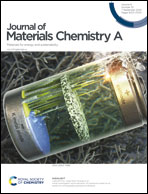Controlled chelation between tannic acid and Fe precursors to obtain N, S co-doped carbon with high density Fe-single atom-nanoclusters for highly efficient oxygen reduction reaction in Zn–air batteries†
Abstract
In this work, three-dimensional N, S co-doped carbon with high density Fe-single atom-nanoclusters of homogeneous dispersion (N, S co-doped CPANI–TA–Fe Fe-SA-NC catalysts) is successfully prepared by the optimal pyrolysis of freeze-dried polyaniline (PANI) hydrogels containing homogeneously distributed Fe precursors due to the controlled chelation between tannic acid (TA) and ferric ions and the interaction between Fe precursors and PANI for the first time, to the best of our knowledge. More importantly, active species (such as Fe single atoms, Fe-SA-NCs and Fe NPs) in the 3D N, S co-doped carbon materials can be controlled by judiciously adjusting the Fe-to-TA molar ratios. High density Fe-SA-NCs as active species (up to 5.6 wt%) in the N, S co-doped carbon are realized by controlling the Fe-to-TA molar ratio at 10. In addition, these Fe-SA-NCs are composed of isolated Fe-SAs, which are separated by the coordination with four N atoms and two O atoms. The resulting N, S co-doped CPANI–TA–Fe Fe-SA-NC catalysts for the oxygen reduction reaction (ORR) exhibit a higher half-wave potential (0.923 V vs. 0.88 V of Pt/C), a higher onset potential (1.09 V vs. 0.99 V of Pt/C), a higher kinetic-limiting current density (12 mA cm−2 at 0.9 V) and better long-term stability in alkaline media. Their ORR activity in acidic media is comparable to those recently reported in the literature. Additionally, the suitability and durability of N, S co-doped CPANI–TA–Fe Fe-SA-NC catalysts as the air electrode of a zinc–air battery were investigated. The fabricated Zn–air batteries exhibited a higher power density of 136.4 mW cm−2 and a higher specific capacity of 795.1 mA h g−1, which are better than those of the state-of-the-art commercial Pt/C catalyst. Our synthetic strategy can be extended to prepare other metal nanocluster-based porous carbon materials as electrocatalysts in electrochemical energy devices, as TA can be chelated with diverse metal ions.



 Please wait while we load your content...
Please wait while we load your content...